69
Last Run of Steam Locomotive1958-Mar-07
Grand Falls-Windsor, Newfoundland, Canada
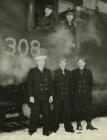 Credits:
Credits:Grand Falls Windsor Heritage Society A.N.D Collection
70
Grand Falls Central Railway1909
Grand Falls-Windsor, Newfoundland, Canada
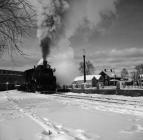 Credits:
Credits:Grand Falls Windsor Heritage Society A.N.D Collection
71
Steam Locomotive1909
Grand Falls-Windsor, Newfoundland, Canada
 Credits:
Credits:Grand Falls Windsor Heritage Society A.N.D Collection
72
Grand Falls Central Railway Steam Locomotive1909
Grand Falls-Windsor, Newfoundland, Canada
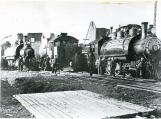 Credits:
Credits:Grand Falls Windsor Heritage Society A.N.D Collection
Photograph by E.I. Bishop
73
Railway Construction 4.5 miles from Grand Falls1907
Botwood, Newfoundland, Canada
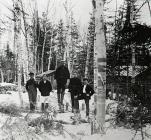 Credits:
Credits:Grand Falls Windsor Heritage Society
74
The UnionsThe A.N.D. Company had acquired the skilled craftsmen from wherever they were available throughout the industry and many of them knew what a union was and what it could do, thus contact was made with the international union and on May 2, 1910, Grand Falls saw the birth of its first chartered union, the United Brotherhood of Papermakers (UBP) Local 88.
In those days only the boss machine tenders, machine tenders, and back tenders were permitted in the union. Therefore, the membership was small, but nonetheless effective.
75
The Unions1936-Jul-27
Grand Falls-Windsor, Newfoundland, Canada
 Credits:
Credits:Grand Falls Windsor Heritage Society
Ron Smith
76
17 Unions Movement Labour Day1936-Jul-27
Grand Falls-Windsor, Newfoundland, Canada
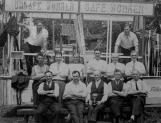 Credits:
Credits:Grand Falls-Windsor Heritage Society
Bert Andrews
77
The new union immediately set about trying to improve some of the working conditions and wages for its membership and, no doubt, made some gains in those areas with seniority and promotions by line of progression. Other workers within the mill could see the results of this effort and talks of a union for others began circulating. Employees in the log hall, grinder room and other departments began to realize they, too, could have some input into the conditions they worked under and the wages they earned, as well as seniority, a method by which progression from one job to another, that is from one job to a higher paid one, could be determined in a fair and equitable manner. As a result, in 1913, 27 men met to discuss the formation of a union. They chose Charles Watkins to head the movement and make the necessary inquiries. He sought the assistance of the Papermakers Union, and was in turn, directed to the International Brotherhood of Pulp, Sulphite, and Papermill Workers International Union (BPSPW), whose jurisdiction could look after the needs of all those who worked outside the paper machine department.Upon the advice of the international president of the BPSPW, Mr. Watkins submitted a letter of petition, signed by 27 men, requesting the formation of a local union. Upon receipt of this letter, a charter was sent May 20, 1913 that carried with it the following names of the chartered members: Charles Watkins, James Peddle, Jacob Scott, Matthew Peddle, James Woodman, Silas Day, Richard LeDrew, William Lane, Edward Flood, Robert Moss, John King, George Osbourne, Arthur Moss, Theodore Brown, Owen Brown, Philip Brown, Samuel Brace, James Heffrin, Henry Lehr, Nathan Sutton, Manuel Oldford, Charles Gosse, Joseph Burton, Joseph Lane, Matthew Rourke, Kenneth Squires and George Bishop.
At their first meeting they selected the officers to run the new local and Alphonsus Gregory Duggan was elected president. Because of the illness within his family, relating to his wife and daughter, Mr. Duggan saw fit to resign as president after only a few months. Although his term of office was cut short, it was the beginning of a very illustrious and distinguished career for Mr. Duggan.
Mr. Watkins was called upon to take over the position of president for the remainder of 1913 and he was re-elected in 1914 and again in 1917.
The local had to overcome great obstacles to stay in existence, such as isolation, the A.N.D. Company's failure to recognize them and the local's own lack of experience and knowledge in trade unionism,. Despite that, exactly one year after receiving its charter, the local was successful in negotiating a collective agreement with the A.N.D. Company
Over the next few years, interest in the union tended to rise and fall until, around 1920, there were approximately 1,000 members in Local 63. Up until 1921, the local had good relations with the A.N.D. Company but then poor conditions in the world market forced the company to resort to drastic actions. It reduced the work week, cut wages and greatly increased the cost of essential goods, such as coal, flour and sugar.
On May 9, 1921, at 7 a.m., the first strike took place at the Grand Falls mill. The three-month strike had a disastrous effect on the union, both financially and morally. So much so, that by 1925, the international president of the IBPBW, ].P. Burke, persuaded a Newfoundland reporter, residing in New York, to come to Newfoundland and re-organize Local 63. So began one of the many careers of Joseph A Smallwood. He was now for the first time a union organizer.
Mr. Smallwood found, to his surprise, that the union membership had depleted from the once 1,700 members to a mere 100 members. Within one year, Mr. Smallwood built up the membership of Local 63 to 1,900. During his stay in Grand Falls he helped organize the very first Federation of Labour which disbanded within a couple of years.
IBES and PAW Local 63 moved along fairly smoothly but were plagued by financial problems, particularly in relation to the collection of union dues prior to the introduction of the "check-off" system. To try and keep the finances in order, the local hired a financial officer, Bessy Connors. She was the only female officer in the history of the local until the 1990s .
In an interesting note to the international union,in 1915, James Randall wrote the following: "At our last meeting there was a committee appointed to hunt up a block of land for building purposes. It really looks like that we are going into the building business. This will be an eye-opener to some of the non-union men and also to the chicken-hearted fellows that were in our union and are now on the outside. I hope those fellows will get their eyes open that wide that they will never get them shut again against unionism.".
In the years following the certification of Local 63 in 1913, and the re-organization of the local by Mr. Smallwood in 1925, UBP Local 88 continued to represent its members and continued to improve the conditions under which these people worked. Other workers in the mill became convinced that they too should have a union. During the late 1930s and the early 40s, these workers contacted international unions whose jurisdiction lay within the scope of work being performed in those specialized fields. As a result, the electricians at the mill, became a chartered local with the International Brotherhood of Electrical Workers (IBEW) Local 512, on March 17, 1939.
78
Brotherhood of Papermakers Charter1910
Grand Falls-Windsor, Newfoundland, Canada
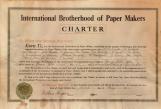 Credits:
Credits:Grand Falls-Windsor Heritage Society
Ron Smith
79
Around the same time the mechanical trades people had made contact with the appropriate union for their jurisdiction and as a result of this effort, in 1948 the town of Grand Falls witnessed the formation of the International Association of Machinists and Aerospace Workers (IAMAW) Lodge 1906. Nehemiah Pinsent was the first at the helm as president and Ed Raines was its first recording secretary.In 1932, several hundred loggers on the west coast of Newfoundland rebelled. They staged a spontaneous strike when International Power and Paper Company announced its second cut in the price of wood. But the loggers were scattered, unorganized, hungry and without money or leadership, so the strike failed. A man who knew of the strike and about conditions in the woods, was John Joseph Thompson of Point Leamington. Even though Thompson knew almost nothing about unions or organizing, he decided that a union was what loggers needed. On August 3, 1935 he called a meeting in Point Leamington and told the loggers he was willing to organize a union if they would back him up. They said they would and elected Thompson leader of the union yet to be named. Thompson then wrote two letters-one to former Prime Minister Richard Squires, who had returned to his law practice, and the other to the A.N.D. Company. Squires agreed to become the union's legal advisor and he and Thompson drew up a constitution and a set of by-laws.
On April 11, 1936 Thompson travelled to St. John's and registered a constitution for the Newfoundland Lumbermen's Association (NLA). Like the FPU, with which Thompson was no doubt familiar, it authorized the creation of local councils with the authority to hold meetings, collect dues and handle local issues but left the authority to set policy and negotiate with a central committee of management. Thompson had hoped the A.N.D. Company would accept the idea of a union for its loggers. The reply he received to the letter he wrote the company, however, left no doubt the company was not going to co-operate.
Thompson asked repeatedly for permission from the company to visit the logging camps and it was refused. So, at the end of July, 1936, he decided to visit the camps without the company's permission. There was a sense of urgency in Thompson's mind. If the union was going to have leverage with the company, he knew its most effective weapon would be to cut the supply of wood to the mill, That was best done after the wood had been cut and hauled to the riverbanks for the spring drive. Thus it was crucial to sign up members before the spring.
With $15 in his pocket, Thompson went to Goodyear's Hardware store in Grand Falls to buy a bicycle to pedal his way up to the A.N.D. logging camp at Bishop's Falls. While he was in the store he got a call from the company's woods manager, informing him that the company had reconsidered. Not only had it decided to let Thompson visit the camps, it would provide him with a car and driver. However, Thompson was surprised to learn that even though the company had allowed him access to the camps to sign up the loggers, they were not willing to recognize the union or negotiate with it. It was Thompson's nature to want to avoid confrontation with authority whenever possible but reluctantly he issued his threat to stop the spring drive. The company did not believe he had the support of the loggers and it rejected his plea for negotiations once again. Perhaps as much to Thompson's surprise as the company's, the loggers did respond by laying down their axes. Two days later the company gave in. An agreement was signed, raising the range of prices paid for a cord of wood from between $1 and $1.30 to between $2 and $2.50. The hourly rate for labourers, such as drivers, went from 21 cents an hour to 26 and 28.5 cents an hour.
80
Labour Day ParadeMid 1900s
Grand Falls-Windsor, Newfoundland, Canada
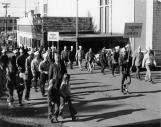 Credits:
Credits:Grand Falls-Windsor Heritage Society
Ron Smith
81
ANDCO and ASARCOThe Anglo-Newfoundland Development Company (AND CO) and its partner, the American Smelting and Refining Company (ASARCO) formed a joint venture which netted their owners and shareholders tremendous wealth. The history of this venture is taken from the following site and is quoted following the citation.
http://www.heritage.nf.ca/society/buchanstown.html
Though the Mi'kmaq are believed to have known about the mineral deposits in the Buchans area at least as long ago as the 1850s, it was not until 1905 that the Anglo-Newfoundland Development (AND) Company, attracted to the island by the prospect of a lucrative pulp and paper industry, hired a local prospector to investigate the Red Indian Lake area. In the same year, Matty Mitchell, who had both Mi'kmaq and Innu ancestry, brought out samples which were found to contain a combination of zinc, lead, copper, gold, and silver.
Mitchell got two dollars and fifty cents for his trouble, and crews set to work to develop the site. The problem, however, was how to separate the various minerals from each other. No suitable process had been developed up to that time, and despite repeated attempts in laboratories as far away as Sweden, it was not until 1925, with the introduction of "selective flotation" technology, that the ore became commercially marketable.
The solution to the separation problem was largely the result of the involvement of the American Smelting and Refining Company (ASARCO), a giant US-based firm owned by the Guggenheim family. In 1915, ASARCO and the AND company had joined forces to work on the problem, and in 1926 when the separation process was established, ASARCO and AND entered into a formal partnership to develop the resource.
The A.N.D. Company was in a particularly advantageous position when it came to the Buchans mineral deposits. Under an agreement dated June 15, 1905, the AND Company and its subsidiary, Terra Nova Properties, had been granted land and mineral rights to 2,320 square miles in central Newfoundland, for a period of 99 years. The Buchans mining operations came under "The Manufacture of Pulp and Paper Act" of 1905, whereby the company would pay an annual royalty of 5% of the net profits.
82
ANDCO and ASARCO: Anglo-Newfoundland Development Company and American Smelting and Refining CompanyCirca 1910
Newfoundland, Canada
 Credits:
Credits:Photograph: Taylor, S.J. The Great Outsiders; Northcliffe, Rothermere and The Daily Mail. Copyright © S.J. Taylor, 1996
Text: http://www.heritage.nf.ca/society/buchanstown.html